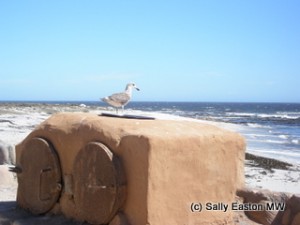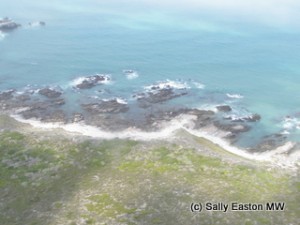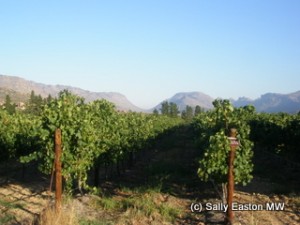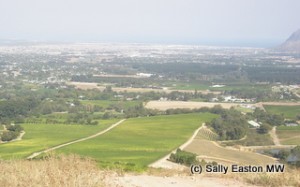South African model of cooler climate
A version of this article first appeared in the Drinks Business magazine, October 2009.
Understanding the cooler aspects of the South African climate is complicated. South Africa’s climate is undoubtedly warm Mediterranean and hot continental. But that’s only part of the story. There are a number of cooling influences, most notably those from both proximitous oceans, giving some validity to the old adage that if a vineyard can see the sea, it’s a good vineyard.

Lambert's Bay, Atlantic Coast
When the various cooling influences are combined with precise viticultural techniques and pristine winemaking, a sometimes quite remarkable new world expression of coolness appears in the wines.
In the search for cool climate, some have tried to come up with sound bite definitions and Charles Back of Fairview was succinct with his “cool climate is where grapes take a month longer to ripen than traditional areas such as Stellenbosch and Paarl … in Darling they’re harvesting chardonnay at the end of February, and they were finished in Paarl a month before.”
Andrew Gunn at Iona in Elgin agreed, saying “to me the proof of the pudding is in the grapes, and picking date. You can’t claim to be cool climate if you’re picking sauvignon blanc in Jan or February” before moving onto a stylistic element “cool climate wines are more elegant, more restrained.”
Winds and coastal proximity
Constantia and Walker Bay are the traditionally-regarded ‘cooler’ climate regions in the South African paradigm. Both are close to the cooling effect of the oceans, so as the land heats up during the day, air rises, sucking in cooler ocean air, the effect of which can be felt up to 15km inland.
Dr. Victoria Carey, at the department of viticulture and oenology, University of Stellenbosch, said: “the sea breezes cool on two levels: humid air, and air movement which prevents a build-up of heat. Closer to the coast, the cooling effect is by way of the humid air, even to the Bottelary Hills. By Stellenbosch, [about 20km from the coast] the breeze has lost most of its humidity, but there is still air movement.”

Over Elim vineyards, Indian Ocean coast
There is also differential cooling according to the current of influence. Pioneer vineyards are popping up along the west coast, north of Cape Town. The Antarctic-origin Benguela current that sweeps up the west coast is said by locals to be icy (though ‘quite warm’ to a northern European perception), varying between about 10°C and 15°C, and is cited as bringing about a 5 to 7°C cooling. This is cooler than the Agulhas current that sweeps southwards from equatorial parts down the east coast of Africa then westwards around False Bay. The temperature of Agulhas varies from 14°C to 26°C, with a suggested 3 to 5°C cooling for areas within its breath.
Then there is the renowned south-easterly Cape Doctor, more prevalent during spring and summer, which both cools the vineyards, and inhibits disease development.
Even though the South African vineyards are at similar latitudes to those in Australia, Argentina and Chile, Dawid Saayman, a soil specialist for Distell, said: “we’re cooler because of the oceans. In South Africa we’re a pimple sticking out in the ocean.” Carey cited Valérie Bonnardot’s study of South African sea breezes which found the maximum temperature of coastal areas is lower than inland, and the maximum temperature happens earlier in the day, adding that temperatures can drop by as much as 6 or 7°C within two hours.
The wind theme is well worked by Cape Point Vineyards, on the south west facing slopes below Constantiaberg. Winemaker Duncan Savage admitted “cool is a relative word. You can never have a vintage and not expect a heatwave.” But, he added “where we have not done bunch exposure, we’ve got green flavours” highlighting the need to manage the effects of the regular south-easterly winds from False Bay which are persistent enough to damage the ends of the vine rows facing head-on into the wind so it blows down the whole row.
Aspect, altitude and attitude
Proximity to the oceans is evidently a big part of this, and in the post-quota era vineyards have been vying to be closest, with Fryer’s Cove, just 800m from and 20m above the Atlantic Ocean pretty well-placed for the nearest.

Cederberg, 1,000m up
The topography of the Cape is as complex as the mesoclimatic picture. In Elgin, for example, which is surrounded by mountains, the winds bring welcome cloud cover. Anthony Rawbone-Viljoen, owner of Oak Valley, said: “the cooling south easterly prevailing wind in summer brings cloud cover in the valley. The cloud cover gets trapped against the mountains and it can be 10°C cooler than Somerset West. This is a regular occurrence and a major contributor to our climatic opportunity.”
Over on the west coast, one hour north of Cape Town, fogs come rolling in 5 to 10km towards Darling, the new darling region of sauvignon blanc. Back said they are “seaward facing vineyards, with breezes off the coast. We get 5-6° C lower than [Paarl], and the temperature drops dramatically overnight.”
Bruce Jack of Constellation’s Flagstone said: “In South Africa we have more wind than any other grape growing country, both speed and volume. At our farm in Overberg, the farm’s hottest time of day is abut 11.30am. We’re at 400m, up against a mountain. The wind goes up the mountain, cools and comes down again. The farm is at 24°C instead of 30°+ if there was no wind chill.”
At 1,000m above sea level, Cederberg exemplifies the cooling effect of altitude, where high altitude also gives high diurnals. It became wholly a wine farm just in 1997. Owner David Nieuwoudt said: “there are no heatwaves up here. We don’t have to spray for downy mildew [as coastal vineyards need to do]. Our normal night time temperature is below 10°C even in summer, and the day time temperature can reach 30°C, giving a 20 to 25°C difference between day and night” which enables the grapes to retain natural acidity.
In Constantia, it’s the mountains again that provide relief, both in terms of aspect and shade. Constantiaberg itself is over 900m. Its height means the sun has gone over top of mountain, shrouding the east-facing vineyards in shade, while vineyards further east such as in Stellenbosch, and Simonsberg continue to receive another 1-2 hours sunshine.
Combine this with an afternoon breeze for extra cooling, as Lowell Jooste of Klein Constantia said: “we’re 7 km from the sea [at False Bay]. The afternoon breezes cool the south-facing slope by 4 to 5°C. And at 300m the altitude is also significant, as we’re exposed to the south-east wind at higher altitude.” He added “sunlight hours are another thing here. We have significantly less sunlight at end of day as sun sets over the hill [Constantiaberg], but we still have day light for photosynthesis to continue.”

Steenberg to False Bay
It’s a similar story at Steenberg, a couple of kilometres closer to False Bay, where wind and aspect are again important factors. John Loubser, their winemaker and general manager, said: “we face east for the morning sun. But by 5.30pm the sun is ducking behind the mountain. We can see Stellenbosch getting another 1.5 hours of sun.”
It’s not all about being high altitude or sitting in the shadow of altitude. In more coastal areas, closeness to sea level to maximise the winds. In Elim, which is, according to Nieuwoudt, “by far the coolest spot in South Africa, where you don’t buy land you buy wind.” Dirk Human, Black Oystercatcher’s owner confirmed this, saying “We get wind 400 [exaggeration intended] days a year. We have ocean on three sides. If we didn’t have wind we’d be a hot climate. Wind puts the characters in the grapes.”
Whatever the aspect and altitude, attention to detail in the field can moderate a warm climate, or take advantage of cooling winds, as at Cape Point Vineyard. “With successfully manipulated viticulture” said Chris Keet of Christopher Keet Wines, “you can sidestep the issue of cool climate.” Greater shading to protect fruit, row orientation to maximise the benefit of breezes or minimise exposure to the sun are all warmer climate techniques to offset the warmth. Gyles Webb at Thelema agreed that “canopy is the single most important thing in the vineyard.”
Pocketing the difference
Given the complex topography, there are plenty of cooler south (poleward)-facing slopes in all locations which are becoming more popular. Eben Archer the viticulturist at Lusan Premium Wines said: “we’re looking for the cool situations. The best we can do is talk about cool pockets.”
Charles Back supported this, saying “you can find enclaves within both Stellenbosch and Paarl where fruit ripens a month later, for example in the Bottelary Hills, also in Helderberg near where Vergelegen is.” And at Delheim winemaker Brenda van Niekerk said “our coolest slope is at Klapmutskop, directly south facing at 320m above sea level. There’s always a slight breeze. The sauvignon blanc has more green flavours, a little grassy, so I leave it hanging. In Stellenbosch it’s not easy to find these spots.”
Viticultural pockets may be the new South African mantra. Nieuwoudt summed it up: “we’re a hot climate wine producing region and we must concentrate on what we do best. But there are great pockets, for example 5km from [his Cederberg property] it’s 5°C warmer. If we can explore these pockets, if places such as Elim can fine tune their wines, they’ll make phenomenal wines. It will take a while to get to this point.”
Topography: the basis for terroir
The Cape’s ancient geomorphology underwrites its terroir. A complex geological history with several periods of sea flooding and tectonic mountain-building activity ended about 550 million years ago, with further uplifting and folding 250 million years ago. This has given rise to three main bedrock ‘foundations’, underlying diverse soils, topography and geology over short distances.
Dr Victoria Carey, at the University of Stellenbosch, said: “the basement is of Malmesbury shales – sedimentary rocks. There was a period of granite intrusions. After an orogenic period, the sandstones were laid down. Since the Pre-Cambrian, mountains have a sandstone cap, and granite, shale at the bottom.”
- Remnants of Malmesbury shales and schists (1bn to 600m years) are hills of 20m to 200m such as in Swartland. Shales often surround granite instrusions and undulating hills.
- Granite intrusions (600 and 500m years) include Paarl and Paardeberg mountains, Bottelary Malmesbury and Darling Hills, as well as granitic foothills of sandstone mountains e.g. Table mountain, Stellenbosch mountain, Hottentots Holland, Helderberg, Simonsberg.
- Deposition of the Cape Supergroup, including the Table Mountain sandstones (400 to 300m years) were originally overlain on eroded shales and granite intrusions, and has itself been eroded to leave e.g. Table Mountain and Simonsberg on granite foothills.
Though soils are derived from these three main rock types, different climates over geological time have complicated the picture further: tropical soils developed just past the Cambrian resulting in stable, weathered, acidic soils with few nutrients. And a Mediterranean climate developed after the Benguela current formed, with a different rainfall and weathering pattern.
South African wine regions showing traditional climate data, with European comparisons
There’s no Winkler region I in South Africa, which emphasises Winkler is useful only as a start point from which refinements and modifications need to be made to explore viticultural climate. Flagstone’s Bruce Jack said: “the Winkler definition of cool climate doesn’t work here, because it’s a sum of averages.” He’s got a point: take two examples from Winkler IV: Springfield (Robertson) has long made one of the zestiest and steeliest sauvignon blancs from South Africa, and Cederberg (Cederberg) makes pristine wines from varieties not traditionally associated with Winkler IV.
| Mean temperature of warmest month | Heat degree days (HDD) | Winkler region | |
| Elgin |
19.7 |
1502 |
II |
| Walker Bay |
20.3 |
1660 |
II |
| Elim |
20.3 |
1683 |
II to III (just) |
| Constantia |
20.6 |
1742 |
III (low end) |
| Durbanville |
20.8 |
1728 |
III (low end) |
| Stellenbosch |
21.5 |
1945 |
III to IV (just) |
| Darling |
22.7 |
1739 |
III |
| Cederberg |
22.8 |
2036 |
IV |
| Robertson |
23 |
2181 |
IV |
| Paarl |
23.2 |
2146 |
IV |
| Rheingau |
18.6 |
1042 |
I |
| Champagne |
18.9 |
1031 |
I |
| Burgundy |
19.7 |
1164 |
I |
| Bordeaux |
20.3 |
1392 |
II (low end) |
Sources: Wines of South Africa
Viticulture and Environment by John Gladstones
NB: values from different sources may not be directly comparable.
This article was researched during a visit to South Africa in March 2009, sponsored by Wines of South Africa.



